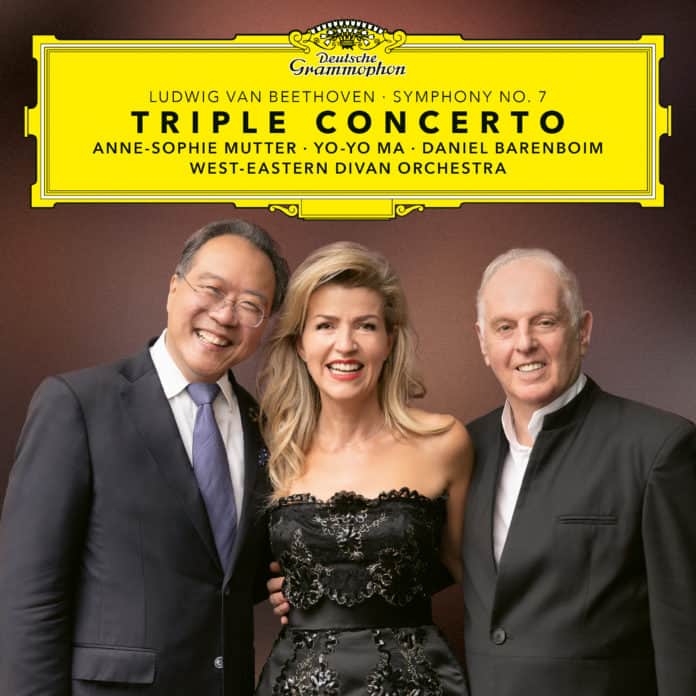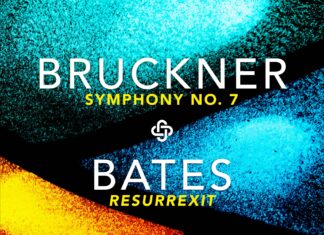Music Review: Beethoven, Triple Concerto & Symphony 7 / Anne-Sophie Mutter (violin), Yo-Yo Ma (cello), Daniel Barenboim (piano & conductor) / West-Eastern Divan Orchestra / Deutsche Grammophon
The High Arts Review Rating: ★ ★ ★ ★ ★
Will this be the last great Beethoven 7th?
One could argue that Barenboim’s Beethoven 7th with the Staatskapelle Berlin is the closest thing to an ideal performance. This new rendition, this time with the West-Eastern Divan Orchestra, is quite a different beast, more alert, vivid and exciting, perhaps not as perfectly recorded (taken from a live concert) but, at the end of the day, equally enjoyable and a truly great achievement.
From the very beginning, you know that musical expressiveness is going to be the core ingredient here. There are performances where the opening chords sound rigid or loud with too much emphasis on the timpani, following the latest HIP standards. And there’s a paradox here — and what a delightful paradox that is: even though Barenboim allows for plenty of air to let the music breathe, he manages to keep the tempi on the fast side resembling those of HIP recordings. This means that the entire performance is significantly faster than his Staatskapelle Berlin album but, at the same time, never feels rushed.
There are also pleasant surprises. Bearing in mind that this is taken from a live concert, the textures are transparent and clear. Only on very few occasions, the recording could have allowed for just a tiny bit of more transparency. But recorded sound aside (which is excellent overall), it’s the performance that counts. And thanks to Barenboim and the remarkably characterful West-Eastern Divan Orchestra, this is a luminous performance.
How is this 7th different in such a crowded field? First of all, there’s the textural opulence (without sacrificing clarity) of the orchestra. Barenboim is generous with rubato, and the expressiveness of the strings is a rare occurrence among modern recordings of the Beethoven symphonies. Listen, for example, to the singing line at 5:55 in the first movement. Or notice why it is so essential to divide the violin decks left and right on stage: the antiphonal effects really stand out under Barenboim’s baton. Not to mention the sweet, vulnerable sound of the woodwinds (9:17 onwards at the end of the same movement). This is playing from another era, looking back at the fluency of the master conductors from the past.
I have praised the richness of the strings already, but perhaps one should listen to the famous Allegretto to hear them truly sing. Like a sculptor, Barenboim moulds the phrases meticulously — clearly this repertoire is a labour of love for the conductor. I could go on and argue that this second movement is amongst the most musical accounts I have encountered, and the truth is that Barenboim goes even further: he sustains the tension and produces pure drama — a trait so crucial here.
This tension carries on and intensifies in the Presto, which has the right balance of fury and contemplative graciousness. And speaking of fury, such is the speed with which Barenboim thrusts in the final movement, that unfortunately, the first timpani entry has not been captured by the recording in all its glory, but fear not: the percussion, in particular, is clearly present and powerful throughout the whole performance. And what a performance of the “apotheosis of the dance” this is! The Allegro con brio is indeed a thrilling ride, among the fast accounts on record, where every phrase not only stays in place but also creates further momentum. It is evident that, for Barenboim, this is not routine conducting and that he has carefully re-thought this symphony. Compared to both his earlier recording with the same orchestra and with the Staatskapelle Berlin recording, he applies new interpretive ideas here and there, especially concerning dynamics and phrasing. A case in point is the diminuendo he introduces before the great orchestral outburst in the climax towards the end: here it is much softer and effective than in his previous accounts.
So, with so many accolades, are there any misgivings? My only criticism has to do with the very few instances (I only counted three) where the live recording doesn’t allow for the instruments to fully cut through (in the Staatskapelle set, for example, the blazing horns are the highlight). But since this performance has been so vividly captured overall, and bearing in mind the superlative quality of the music-making, this is a small price to pay.
In my introduction, I asked whether this will be the last great recording of the 7th. And with that, I was referring to the big-band, full-toned, musical accounts of the great master conductors. Barenboim is undoubtedly among them, and there are few musicians left who still carry on with this tradition. Musicality is a key characteristic of the conductor, respect for the score is another, and one should also add expressiveness to this list. Here he provides us with a fast, HIP account of this warhorse symphony which at the same time is highly musical, a feat attained by few.
Triple Concerto: Nobility and Expression
There are some notable recordings of the Triple Concerto that manage to capture Beethoven’s fiery passion and which are perfectly executed (Paavo Jarvi with Angelich, Shaham and Gastinel; Zinman with Bronfman, Shaham, Mork). Barenboim’s account might not be as volatile but, like in his coupling of the 7th symphony, he produces a rich sound without sacrificing textural clarity.
Indeed, I could begin by praising the orchestral contribution of the West-Eastern Divan Orchestra, their lively accents, the (once more) excellent use of antiphonal effects (listen for these at 3:15 in the first movement). But here the three soloists take centre stage. And let us not forget that Mutter and Yo-Yo Ma recorded the same piece under Karajan precisely 40 years ago! In the previous recording, their playing was more athletic and carefree, now it sounds more mature and inventive. Both are valid accounts of course.
So, let’s focus on this recent release. Yo-Yo Ma’s first entry, mellow and spirited, is a harbinger for things to come. And when Mutter joins later with her assertive lyricism, followed by Barenboim’s crystalline-quality pianism, you know you’re in for a treat. It is apparent that all three soloists have a distinct character and bring their own voice to this minor masterpiece. In fact, so distinguished and personal is each other’s contribution, that if we experimented by substituting one soloist, the result would probably sound disappointing. This is inspiring music-making caught on the fly.
But for me, the highlight of this release is the last movement, where Mutter and Yo-Yo Ma display their flawless virtuosity, but it’s not just that: they have the ability and courage to infuse their own individual touches. As for Barenboim, being a conductor and a soloist in this piece, he knows how to drive the orchestra’s tempo forward in what is an alert reading of the finale. And his pianism is never short of imaginative: just pay attention to his handling of the solo passage from 5:22-5:35 — I have to confess, I haven’t heard such fitting use of rubato in any other performance of this work!
This is an A+ release and not just for the line-up of superstar musicians. Here we have both the Concerto and the Symphony re-thought by Barenboim in refreshing, thoughtful accounts, where musicality is the key word. The West-Eastern Divan orchestra sounds like a world-class ensemble. As for Barenboim, Mutter and Yo-Yo Ma, all I can say is that their individuality brings fresh air to this oft-heard concerto. DG has managed to capture both performances in very good sound this time, these being live concerts. Not to be missed.







[…] partnerships of recent years (Jansons/Bavarian Radio Symphony Orchestra or the new Barenboim/Easter-Western Divan Orchestra come to […]